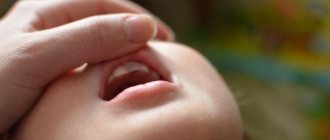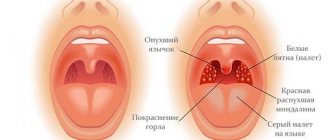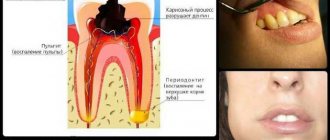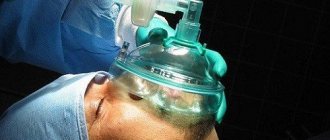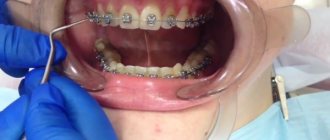Development mechanism
Bruises and swelling after a bruise on the face are common phenomena that require mandatory examination by a doctor. When struck, tissues and blood vessels may be damaged, and this can lead to unpleasant consequences for health.
Note! You should be especially careful about hematomas near the eyes when there is severe hemorrhage and decreased visual acuity. This can lead to complete blindness and other serious visual problems.
Usually, after a bruise, a swelling and swelling forms on the face, and over time a bruise appears. When sharp pressure or strong compression of the tissues at the site of impact occurs, the integrity of the tissues and small blood vessels is damaged. But the skin itself has a stronger structure, capillaries burst underneath it, fragile vessels break, but the skin remains intact. Fluid is released from the tissues, resulting in hematoma and swelling.
At the initial stage, the swelling is milder, but often it quickly increases in size. After approximately 8-10 hours, a hematoma appears. Under the skin, the blood hardens, first the skin becomes purple in color, and then turns into a dark blue color, and finally acquires a purple color.
Swelling of lips and eyes
No part of the human body compares to the face in sensitivity.
Many of us would be prepared to receive a much more serious bruise on another part of the body, just not on the face. Even a minor hematoma and swelling on the face can drive a person into an awkward situation and give rise to many questions. What to do if the blow hits your lips or eyes? A blow to the lip is often accompanied by damage. The skin of the lips is very delicate and thin, so it bursts quickly. In addition, the capillaries on the lips are located close to the skin, so such hematomas are more obvious and larger. If you receive a blow to your lip, you should try to disinfect the wound as quickly as possible. After this, ice is applied to the site of the bruise, placed in a bag and wrapped in cloth. The bruise site should be lubricated with wound-healing ointments. Use sea buckthorn or almond oil - they will moisturize the skin of your lips and help relieve swelling.
If a blow hits the area around the eyes, you need to be very careful. After all, the eyes are a sensitive organ that can also be damaged by a blow. It is best to consult a doctor after the incident. He will check the condition of the lens and retina of the eye. A visit to the doctor should be mandatory if you notice deterioration in your vision after the impact.
Dizziness, deterioration in general health, nausea, loss of consciousness - this is a reason to immediately consult a doctor. If the person’s general condition remains unchanged, swelling after an impact can be treated at home. Usually the hematoma and swelling go away in about two weeks. With our tips, you can cut your healing time in half.
how to relieve swelling after a broken arm
Causes
Severe bruises lead to swelling and bruising on the face. But this can be caused by various reasons. This usually occurs during a strong fall, especially from a height. Unsuccessful sports activities, jogging, sudden movements, carelessness and non-compliance with safety precautions. All this can lead to a blow to the face and the formation of severe swelling.
Among the main reasons are:
- jumping and falling from heights;
- traffic accidents;
- fights, blows to the face with a fist or a blunt object;
- impacts on furniture and other structures;
- active sports - boxing, wrestling, karate, strength training.
Swelling, contusions and bruises on the face are often observed with sudden movements, blows, or falls. A person may inadvertently fall and hit his face hard, resulting in a large hematoma appearing in this place.
Contusion of soft tissues of the face
A bruise of the face, or rather its soft tissues, is expressed by severe swelling and hemorrhages in the tissue - this is explained by the large blood supply to the facial tissues and a lot of fatty tissue.
In this case, a facial bruise necessarily manifests itself as hematomas and is easily determined by palpation. Swelling and hemorrhages that arise as a result of the injury may be accompanied by damage to the skull bones of the face or teeth, or even the entire jaw.
Diagnosis of suspected contusion of soft tissues of the face is carried out based on the results of anamnesis, palpation, examination of skin tissue and the oral cavity. If there is a possibility that, in addition to a bruise, a bone fracture is possible, then an x-ray is taken.
Let's take a closer look at bruises of the soft tissues of the face. It is already clear that the skin or mucous membrane, the integrity of which is compromised, is a sign that the soft tissues are damaged. In addition to the fact that swelling and hemorrhages are present on the face, there is also an additional feature: a significant divergence of the edges of the wound. This phenomenon is purely visual in nature, since it can be called an “optical illusion”, provoked as a result of reflex contractions of facial muscles.
The soft tissues of the face also include the lips; for example, if the lower lip is injured, strong salivation may occur outward, during which maceration of the skin of the neck and chin occurs.
Injuries to the soft tissues of the face often affect the branches of the facial nerve, the parotid salivary gland or its excretory duct.
Facial bruising can be complicated by bleeding, shock, and asphyxia. It is possible that, at the time of injury or blow to the face, the tongue swells, and if it sinks inward, dislocation or obstructive asphyxia may occur.
Bruises of the soft tissues of the face, which are directly related to the oral cavity, can affect the development of inflammatory complications:
What are the symptoms of bruises of the soft tissues of the face?
- Gaping wound with bleeding.
- Pain accompanied by difficulty opening the mouth, let alone eating or speaking.
- Difficulty breathing.
What determines the degree of complexity of the post-traumatic process?
Naturally, first of all, it depends on the size (depth, length) and location of the wound. Also of great importance in this situation are associated complications: blood loss, asphyxia, shock, and so on.
Shock is diagnosed based on sudden changes in the skin, for example, pallor. There is also a weak pulse, low blood pressure, and inhibited consciousness.
As for asphyxia, in this case the skin and mucous membrane becomes bluish; shortness of breath appears; and foamy sputum is released from the mouth.
How to help immediately after an injury
How to remove a tumor and bruise from the face without leaving a trace? It is important to take therapeutic action immediately after the injury, otherwise other unpleasant symptoms may develop, and the hematoma will become more pronounced and pronounced. Moreover, a bruise on the face is always visible, this negatively affects the appearance.
So, you can quickly remove a bruise on the face and its consequences using simple and affordable means:
- The most correct solution would be to apply ice to the injured area. It is advisable to wrap it in a piece of cloth to prevent frostbite. A small piece of ice or frozen meat can be wrapped in a cotton towel and applied to the bruised area. You need to hold it for as long as possible, this will speed up the resorption of blood accumulation and prevent the appearance of a large hematoma and tumor.
- A few minutes after applying ice, you can use a herbal compress. For it you can use plantain leaves, wormwood, St. John's wort, and yarrow. The herbs should be poured with hot water and left to steep. After filtering, the decoction is recommended to be used cold. Then a piece of bandage is soaked in it and applied to the bruised area. As the compress warms up, the bandage needs to be changed to a colder one. Usually, after applying the compress within half an hour, the swelling subsides.
- If you don’t have the necessary herbs for a compress on hand, you can apply a bandage soaked in tea leaves to the injured area. You can keep the tampon for several minutes, and when it gets warmer, you need to replace it with a new cold one.
- If a slight bruise of the face occurs, treatment can be carried out at home. To do this, you can use onion juice. The onion head must be rubbed through a fine grater and the juice must be squeezed out of the pulp well. A cotton pad is moistened in it and applied to the injured area. The juice irritates the skin, increases blood circulation, which accelerates the resorption of swelling and bruises.
- You can relieve swelling and prevent bruising with vinegar. But it is better to use vinegar with a concentration of no more than 10%, otherwise you can severely burn the skin. Under no circumstances should vinegar be applied if there are open wounds or damage to the surface of the skin.
- Swelling and hematomas can be quickly eliminated with the help of fermented milk products - fermented baked milk, kefir. They are always in the refrigerator, so they can help with swelling and also reduce pain. It is enough to lubricate the bruised area with kefir or fermented baked milk and after a short period of time the swelling will decrease.
Note! The remedies are effective in situations where they are used immediately after an injury. If a compress or ice is applied in the first minutes, the swelling will quickly decrease. But in other cases they will be useless.
Facial bruise
All iLive content is reviewed by medical experts to ensure it is as accurate and factual as possible.
We have strict sourcing guidelines and only link to reputable sites, academic research institutions and, where possible, proven medical studies. Please note that the numbers in parentheses ([1], [2], etc.) are clickable links to such studies.
If you believe that any of our content is inaccurate, out of date, or otherwise questionable, please select it and press Ctrl + Enter.
The face is the calling card of any person, and every flaw is not only an external defect, but also the emotional state of a person. When we like ourselves on the outside, we feel “beautiful” on the inside. A facial bruise is a whole complex of reasons for dissatisfaction with oneself: external errors, pain, state of physical and psychological health.
Many people say that appearance is not the main thing. Probably, these people do not understand that there is a facial bruise in the world, which really interferes with life. And besides, we all want to be beautiful and to be with beautiful people (sometimes we keep this a secret so as not to offend others).
Medications
For swelling of the face after a bruise, you can use medications that can eliminate swelling, hematomas, and swelling of tissues. Doctors recommend using external medications that have a calming, anti-inflammatory and analgesic effect.
Important! Compared to folk remedies, pharmaceutical drugs have a stronger effect. They will be able to quickly eliminate the external manifestations of injury.
Before using any drug, you should carefully study the instructions. It is important to consider possible contraindications and side effects.
Troxevasin
If you don’t know how to remove swelling and bruises from your face, then you can use an affordable and effective external remedy - Troxevasin gel. The product has a strong anti-inflammatory and anti-edematous effect. The active substance, troxerutin, penetrates damaged tissue, resolves blood clots and quickly eliminates hematomas.
So how to relieve swelling after an impact using Troxevasin gel? The application is quite simple:
- a small amount of gel should be applied to the injured area;
- the product should be rubbed in with light movements until completely absorbed;
- It is recommended to apply the ointment 2-3 times a day;
- It should be used until the swelling and hematoma completely resolve.
Doctors often prescribe Troxevasin gel for serious injuries that are accompanied by inflammatory processes. The product can be applied to areas near the eyes. But first you need to consult a doctor.
Indovazin
If your face is swollen after bruises, you can use the external remedy Indovazin. It is produced in the form of a gel, which causes the resorption of hematomas. After application, swelling decreases and painful symptoms are eliminated.
Note! The products contain special components that quickly heal wounds, strengthen capillaries, and normalize blood circulation. But do not forget that Indovazin gel has contraindications and side effects.
You should not use Indovazin after a facial injury if you have the following conditions:
- blood clotting disorder;
- diseases of the gastrointestinal tract;
- pregnancy;
- age up to 14 years.
It is recommended to apply the gel to injured areas up to three times a day. The drug should be used until the unpleasant symptoms are completely eliminated.
Badyaga
If the face is very swollen after bruises and a bruise appears, then you can use an effective and natural remedy called Bodyaga. It really helps to quickly eliminate a severe bruise, but still do not forget about precautions.
Usually Bodyaga helps get rid of a bruise in a few days. The product is available in two forms - powder and gel. But if your face is swollen after an injury, then it is better to use the gel, because it does not need to be pre-prepared. It quickly penetrates damaged tissue and eliminates swelling.
Ketonal
Ketonal gel helps eliminate severe swelling and hematomas after a bruise. The product has a strong anti-inflammatory and analgesic effect. After application, it has a calming effect and reduces pain.
The following external agents have a similar effect:
- Diclofenac;
- Voltaren;
- Dolgit;
- Ketoprofen;
- Pentalgin extra-gel.
It is worth noting! Any external remedy with an anesthetic effect should be used in emergency cases. It is recommended to use them no longer than 5 days, otherwise unpleasant symptoms may occur.
Severe facial bruise
A severe bruise to the face, of course, is no joke. And its consequences can be completely different, for example, shock, asphyxia, scars (temporary and untimely), disability (if the injury affected the eye or optic nerve, then loss of vision is possible) and even death.
A severe facial bruise can be accompanied by various symptoms depending on the severity of the injury or blow. In this case, a person may either lose consciousness or “throw around” from side to side. But, be that as it may, the victim should be given first aid and call an ambulance.
In addition, it is very important to remember at this moment about the psychological factor: a person in this situation, in addition to pain, experiences fear, and if he sees panic in the faces of others, then his fear will increase, which affects intracranial and blood pressure, heartbeat, etc. Therefore, it is very important to remain calm or at least pretend that nothing particularly terrible has happened.
What not to do during treatment
If there is a bruise on the face from a blow, then you definitely need to know how to treat this injury. But special attention should be paid to the doctor’s recommendations, because many people take incorrect actions that lead to worsening.
You can prevent the spread of swelling and bruising on the face after a bruise by following these tips:
- Under no circumstances should you warm up the injured area during the first 48 hours after the injury. Intense heat will make the condition worse. You can quickly relieve pain with ice or cold compresses.
- For the face, you should not use Bodyaga in powder form; this form can dry out the skin, especially under the eyes, which can cause unpleasant consequences. It is better to use the product in gel form.
- Do not massage the hematoma and swelling during the first 48 hours. Impact on the injured area can increase subcutaneous bleeding and activate the process of increasing the bruise.
- It is advisable to avoid drinking alcoholic beverages. Alcohol retains fluid in the body. If you want the puffiness and swelling to quickly disappear, then it is better not to drink alcohol at all for the first few days.
- It is worth refusing to visit the bathhouse, sauna, and beaches. Elevated temperatures can lead to increased tissue swelling.
Video: how to remove a black eye
No one is immune from such a nuisance - you may not be a professional participant in “fights without rules” and get hit in the face after a fall, as a result of unsuccessful braking and many other reasons. If you take care in a timely manner about how to remove swelling from the face after an impact, you can significantly reduce the consequences of the injury.
What to do immediately after being hit in the face?
The reason for the appearance of a tumor on the face after an impact is a violation of the integrity of the subcutaneous capillaries and tissues. The skin itself may remain undamaged, but blood and lymph from damaged vessels accumulate under the epidermis layer. In order to stop or minimize this process in time, you need to urgently apply cold to the site of the impact. Ideally, this is ice from the freezer, wrapped in a plastic bag and a linen napkin.
If there is no ice, apply the following to cool the impact site:
- Frozen food;
- A napkin soaked in cold water, green tea (such a compress needs to be refreshed more often);
- Metal objects;
- Copper or any other coin.
All these measures are applicable if the integrity of the epidermis is not compromised and there is no risk of wound infection. Applying cold is advisable in the first 15-20 minutes after injury; after a quarter of an hour, it will no longer be possible to prevent subcutaneous hemorrhage.
Medications to relieve swelling from the face after a stroke
The resulting swelling should be shown to a traumatologist so as not to miss serious complications.
Reason to see a doctor:
- Extensive area of edema;
- Strong pain;
- The impact damaged the eye;
- Combination of injury with fever, dizziness, headache, unusual sensations;
- Swelling persists for 3-5 days.
If there are no serious symptoms, you can try to remove the swelling from the face after the blow yourself. For this purpose medications are used:
- Troxevasin;
- Heparin ointment;
- Indovazin;
- Ointment "Special ointment";
- Lyoton-gel;
- Allantoin;
- Heparoid Zentiva;
- Ointments with Arnica, Comfrey, Larkspur;
- Dolobene-gel.
A proven remedy for eliminating swelling is Badyaga, the skeleton of a freshwater sponge crushed into fine powder. When using all medications, you should take into account contraindications for use and carefully follow the instructions. With proper use of these gels and ointments, you can reduce the duration of swelling by several days.
Found an error in the text? Select it and a few more words, press Ctrl + Enter
Traditional methods of treating swelling after an impact
Traditional medicine recipes offer effective ways to eliminate swelling on the face after an injury.
- Apply raw potatoes, cut into thin slices or grated, to the swelling.
- Make lotions from a decoction of wild rosemary and coltsfoot (2 teaspoons of the collection, boil for 5 minutes and leave for 2 hours).
- Make an iodine mesh at the site of the tumor after the blow; you can add an analgin tablet to the iodine solution.
- Add a mashed cabbage leaf coated with honey.
- Lubricate the tumor with natural butter.
- Apply a compress of cooked chopped beans to the tumor.
What not to do when treating a tumor after a stroke
To speed up tissue restoration, in the first 3-4 days after the blow, it is undesirable to subject your face to thermal procedures (sauna, steam bath), drink alcohol, or massage the tumor site. This can slow down the regeneration of damaged blood vessels and provoke new swelling. If an inflammatory process joins the tumor after swelling, you should immediately seek medical help.
No one is immune from such a nuisance - you may not be a professional participant in “fights without rules” and get hit in the face after a fall, as a result of unsuccessful braking and many other reasons. If you take care in a timely manner about how to remove swelling from the face after an impact, you can significantly reduce the consequences of the injury.
What to do immediately after being hit in the face?
The reason for the appearance of a tumor on the face after an impact is a violation of the integrity of the subcutaneous capillaries and tissues. The skin itself may remain undamaged, but blood and lymph from damaged vessels accumulate under the epidermis layer. In order to stop or minimize this process in time, you need to urgently apply cold to the site of the impact. Ideally, this is ice from the freezer, wrapped in a plastic bag and a linen napkin.
If there is no ice, apply the following to cool the impact site:
- Frozen food;
- A napkin soaked in cold water, green tea (such a compress needs to be refreshed more often);
- Metal objects;
- Copper or any other coin.
All these measures are applicable if the integrity of the epidermis is not compromised and there is no risk of wound infection. Applying cold is advisable in the first 15-20 minutes after injury; after a quarter of an hour, it will no longer be possible to prevent subcutaneous hemorrhage.
Medications to relieve swelling from the face after a stroke
The resulting swelling should be shown to a traumatologist so as not to miss serious complications.
Reason to see a doctor:
- Extensive area of edema;
- Strong pain;
- The impact damaged the eye;
- Combination of injury with fever, dizziness, headache, unusual sensations;
- Swelling persists for 3-5 days.
If there are no serious symptoms, you can try to remove the swelling from the face after the blow yourself. For this purpose medications are used:
- Troxevasin;
- Heparin ointment;
- Indovazin;
- Ointment "Special ointment";
- Lyoton-gel;
- Allantoin;
- Heparoid Zentiva;
- Ointments with Arnica, Comfrey, Larkspur;
- Dolobene-gel.
A proven remedy for swelling is Badaga, the skeleton of a freshwater sponge ground into a fine powder. When using all medications, you should take into account contraindications for use and carefully follow the instructions. With proper use of these gels and ointments, you can reduce the duration of swelling by several days.
Traditional methods of treating swelling after an impact
Traditional medicine recipes offer effective ways to eliminate swelling on the face after an injury.
- Apply raw potatoes, cut into thin slices or grated, to the swelling.
- Make lotions from a decoction of wild rosemary and coltsfoot (2 teaspoons of the collection, boil for 5 minutes and leave for 2 hours).
- Make an iodine mesh at the site of the tumor after the blow; you can add an analgin tablet to the iodine solution.
- Add a mashed cabbage leaf coated with honey.
- Lubricate the tumor with natural butter.
- Apply a compress of cooked chopped beans to the tumor.
What not to do when treating a tumor after a stroke
To speed up tissue restoration, in the first 3-4 days after the blow, it is undesirable to subject your face to thermal procedures (sauna, steam bath), drink alcohol, or massage the tumor site. This can slow down the regeneration of damaged blood vessels and provoke new swelling. If an inflammatory process joins the tumor after swelling, you should immediately seek medical help.
When to ask for help
Only a doctor can determine how to remove a tumor and hematoma from an impact. If the symptoms are not too pronounced and the injury is not severe, then you can get by with available products and gels. But if complications are noted, it is better to consult a doctor.
Immediate medical attention is required if the following symptoms are present:
- after injury there is severe nausea and vomiting;
- the presence of strong pulsating pain in the area of the hematoma;
- the bump and bruise does not go away after drug therapy;
- spreading of the bruise to all parts of the face.
Only a doctor can tell you exactly how long it takes for swelling and bruising to go away after a bruise; this process goes differently for everyone. If the injury is mild, then the unpleasant symptoms disappear within a few days, but with severe injuries, recovery can drag on for months. But in any case, it is important to carry out medical therapy as early as possible, then complications and serious consequences can be avoided.
Clinical picture
Many people carelessly often fall, slipping or tripping on a bumpy path or slippery stairs. The upper and lower extremities are most often affected, but facial injury is not uncommon. The most common cause of a bruised cheek with bruises and bruises is a banal fight. The following symptoms are considered typical signs of such an injury:
Swelling and hemorrhage in the tissue occurs due to the fact that in this part of the face there is a large amount of fatty tissue, which is friable, and there is a very intense blood supply to the soft tissues.
A bruise on the cheek requires mandatory treatment under medical supervision, since such an injury is often accompanied by serious complications. The patient may have associated injuries:
- facial nerve;
- oral mucosa;
- salivary gland, including its duct.
If the injury to the soft tissues of the face is open, then the victim has wounds, scratches and abrasions on the damaged cheek. Violation of the integrity of the skin is dangerous because it can be primarily infected. Most often, this type of cheek bruise occurs in a child, and parents are usually worried about what to do and how quickly their baby will recover.
Treatment of bruises of soft tissues of the face
Facial bruising and damage to the soft tissues of the face require special vigilance, since there may be other injuries: fractures, ruptures, etc.
If at the time of the injury there were injuries to the soft tissues of the face, then it is necessary to reject the tension of the skin at the time of applying sutures. Only if necessary, the skin is immobilized to more correctly connect the edges of the wound. Particular care is required when it is necessary to connect the edges of wounds in the area of the lips, nose, eyelids, eyebrows and ears.
If skin defects due to injuries are clearly expressed, then it is impossible to apply sutures without tension, and plastic surgeries are carried out irrationally; in order to reduce the volume of a possible scar, plate sutures are applied.
If we talk about the surgical method of fixing bone elements, then mini-plates, micro-plates, and screws are needed - these are indicated in older people.
A bruise of the face, namely its soft tissues, is treated routinely at the hospital. If the treatment concerns children's health, then conservative treatment is carried out in a hospital setting: sanitation, orthodontic therapy.
Contusion of a child's face
Bruises and other injuries in the chin area can lead to damage to the ligamentous apparatus. With this phenomenon, any movements of the lower jaw provoke pain in the child - one of the reasons to suspect a fracture of the condylar process. To clarify the diagnosis, an X-ray examination is mandatory.
A facial bruise in a child is characterized by the same causes and symptoms as in an adult. But let's not forget that children with great fear endure pain caused by injury, especially if it is accompanied by blood.
In addition, a bruise on a child’s face is serious because the child cannot always explain what exactly hurts and how. From a biological point of view, cell division in children occurs somewhat differently than in adults, just as a child’s body is a growing organism. Accordingly, the processes responsible for the natural development of the skin and muscle parts of the face may be disrupted. But there is a small, but positive side: scars on children heal faster and better than on adults.
But, nevertheless, during the period of screaming or crying, children may develop laryngospasm or may experience breathing problems.
For children, first aid is emergency. Whatever the conditions or setting, the child should be sitting or lying face down. Then you should turn the child on his side for convenience when emptying the oral cavity from the contents. The contents are removed using any safe means: a cotton swab or your hand. It happens that such actions are ineffective, and intubation is performed; tracheotomy is not recommended.
But, no matter what happens, the most important thing is not to panic, but to provide first aid in a timely manner (and not lose consciousness or become hysterical, like some mothers) and call an ambulance.
[17], [18]
First aid for facial bruises
A facial bruise, regardless of severity, requires emergency assistance. But how to carry it out depends on the seriousness of the situation. So,
- bruise of the soft tissues of the face. A bandage is applied, but not tightly. Ice is also applied to the injury site,
- fluctuation is eliminated with a syringe to avoid blood suppuration in the hematoma,
- profuse bleeding. It is necessary to apply an aseptic bandage to the damaged area. In this situation, the bandage is applied tightly to restrict the flow of blood. If it is necessary to stop the blood from the vessels, then this must be done by pressing the vessel with a finger,
- Asphyxia should be prevented in this way: the victim is placed on his side, face down. Foreign objects are removed from the mouth: blood clots and other contents.
A facial bruise, like any other injury, should not be limited to first aid. Professional medical examination and treatment are required.
[19], [20]
